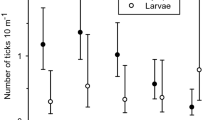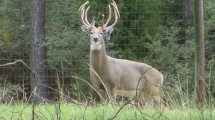Abstract
In studies of tick communities, sampling methodology may influence observed patterns. The objective of this study was to compare two sampling methods, dragging and dry ice baiting, in two habitats to assess abundance of off-host ticks. Tick communities were monitored from March to December in a forested and an old-field habitat in northeast Missouri. In each habitat, eight drag and eight dry ice bait samples were collected every 2 weeks on a permanent grid. The most common ticks collected were all life stages of Amblyomma americanum L. and adult and larval Dermacentor variabilis Say. Capture data was analyzed to determine if there were differences due to sampling method, habitat or an interaction for each life stage of each species across the entire monitoring period. Data indicate that there were differences in the methods. Significantly more A. americanum nymphs were captured by bait sampling. Dragging captured significantly more larval A. americanum. Significantly more larval and nymphal A. americanum and larval D. variabilis were caught in the forest, whereas significantly more adult D. variabilis were collected in the field. Significant interaction between site and method was found for A. americanum adults and D. variabilis larvae. These differences are likely due to differences in behavior among species and developmental age that interact with microclimate. These data indicate that community monitoring studies should use multiple sampling methodologies to avoid bias. While comparing these methods, the first documented collection of off-host Ixodes scapularis Say in Adair County, Missouri was made.




Similar content being viewed by others
References
Alekseev AN, Dubinina HV (2000) Abiotic parameters and diel and seasonal activity of Borrelia-infected and uninfected Ixodes persulcatus (Acarina: Ixodidae). J Med Entomol 37:9–15
Barré N, Garris GI, Lovrvelec O (1997) Field sampling of the tick Amblyomma variegatum (Acari: Ixodidae) on pastures in Guadeloupe; attraction of CO2 and/or tick pheromones and conditions of use. Exp & Appl Acarol 21:95–108
Conover WJ, Iman RL (1981) Rank transformations as a bridge between parametric and nonparametric statistics. Am Statistician 35:124–133
Daniels TJ, Falco RC, Fish D (2000) Estimating population size and drag sampling efficiency for the blacklegged tick (Acari: Ixodidae). J Med Entomol 37:357–363
Falco RC, Fish D (1989) The use of carbon dioxide-baited tick traps for sampling Ixodes dammini (Acari: Ixodidae). Acarologia 30:29–33
Falco RC, Fish D (1992) A comparison of methods for sampling the deer tick, Ixodes dammini, in a Lyme disease endemic area. Exp Appl Acarol 14:165–173
Garcia R (1962) Carbon dioxide as an attractant for certain ticks (Acarina: Argasidae and Ixodidae). Ann Entomol Soc Am 55:605–606
Garcia R (1965) Collection of Dermacentor andersoni (Stiles) with carbon dioxide and its application in studies of Colorado tick fever virus. Am J Trop Med Hyg 14:1090–1093
Ginsberg HS, Ewing CP (1989) Comparison of flagging, walking, trapping, and collecting from hosts as sampling methods for northern deer ticks, Ixodes dammini, and lone-star ticks, Amblyomma americanum (Acari: Ixodidae). Exp Appl Acarol 7:313–322
Guglielmone AA, Moorhouse DE, Wolf G (1985) Attraction to carbon dioxide of unfed stages of Amblyomma triguttatum triguttatum Koch, under field conditions. Acarologia 26:123–129
Harlan HJ, Foster WA (1990) Micrometeorologic factors affecting field host-seeking activity of adult Dermacentor variabilis (Acari: Ixodidae). J Med Entomol 27:471–479
Holscher KH, Gearhart HL, Barker RW (1980) Electrophysiological responses of three tick species to carbon dioxide in the laboratory and field. Ann Entomol Soc Am 73:288–292
SPSS Inc (2007) SPSS 16.0 base user’s guide. Prentice Hall, Upper Saddle River
Jackson LK, Gaydon DM, Goddard J (1996) Seasonal activity and relative abundance of Amblyomma americanum in Mississippi. J Med Entomol 33:128–131
Kinzer DR, Presley SM, Hair JA (1990) Comparative efficiency of flagging and carbon dioxide-baited sticky traps for collecting the lone star tick, Amblyomma americanum (Acarina: Ixodidae). J Med Entomol 27:750–755
Koch HG, McNew RW (1981) Comparative catches of field populations of lone star ticks by CO2-emitting dry-ice, dry-chemical, and animal-baited devices. Ann Entomol Soc Am 74:498–500
Koch HG, McNew RW (1982) Sampling of lone star ticks (Acari: Ixodidae): dry ice quantity and capture success. Ann Entomol Soc Am 75:579–582
Lane RS, Kleinjan JE, Schoeler GB (1995) Diel activity of nymphal Dermacentor occidentalis and Ixodes pacificus (Acari: Ixodidae) in relation to meteorological factors and host activity periods. J Med Entomol 32:290–299
Oliver JH (1989) The biology and systematics of ticks (Acari: Ixodida). Ann Rev Ecol Syst 20:397–430
Randolph SE, Storey K (1999) Impact of microclimate on immature tick-rodent host interactions (Acari: Ixodidae): implications for parasite transmission. J Med Entomol 36:741–748
Schulze TL, Jordan RA (2003) Meteorologically mediated diurnal questing of Ixodes scapularis and Amblyomma americanum (Acari: Ixodidae) nymphs. J Med Entomol 40:395–402
Schulze TL, Jordan RA, Hung RW (1997) Biases associated with several sampling methods used to estimate abundance of Ixodes scapularis and Amblyomma americanum (Acari: Ixodidae). J Med Entomol 34:615–623
Schulze TL, Jordan RA, Hung RW (2001) Effects of selected meteorological factors on diurnal questing of Ixodes scapularis and Amblyomma americanum (Acari: Ixodidae). J Med Entomol 38:318–324
Semtner PJ, Hair JA (1973) The ecology and behavior of the lone star tick (Acarina: Ixodidae): IV. The daily and seasonal activity patterns of adults in different habitat types. J Med Entomol 10:337–344
Semtner PJ, Hair JA (1975) Evaluation of CO2-baited traps for survey of Amblyomma maculatum Koch and Dermacentor variabilis Say (Acarina: Ixodidae). J Med Entomol 12:137–138
Solberg VB, Neidhardt K, Sardelis MR, Hildebrandt C, Hoffmann FJ, Boobar LR (1992) Quantitative evaluation of sampling methods for Ixodes dammini and Amblyomma americanum (Acari: Ixodidae). J Med Entomol 29:451–456
Sonenshine DE (1993) Biology of ticks, vol 1. Oxford University Press, Oxford
Waladde SM, Rice MJ (1982) The sensory basis of tick feeding behavior. In: Obenchain FD, Galun G (eds) Physiology of ticks. Pergamon, New York, pp 71–118
Wilson JG, Kinzer DR, Sauer JR, Hair JA (1972) Chemo-attraction in the lone star tick (Acarina: Ixodidae): 1. Response of different developmental stages to carbon dioxide administered via traps. J Med Entomol 9:245–252
Zimmerman RH, McWherter GR, Bloemer SR (1987) Role of small mammals in population dynamics and dissemination of Amblyomma americanum and Dermacentor variabilis (Acari: Ixodidae) at land between the lakes, Tennessee. J Med Entomol 24:370–375
Acknowledgments
We would like to acknowledge the extensive collection and identification efforts made by Brian Hilliard, Jamie Spencer, Kurt Munzer, and Cara Willoughby. Additionally, we are grateful for the contributions made by those assisting with tick collection, identification, and data management: Enato Esangbedo, Neal Haley, Emily Twining-Gerdes, Rauleen Caballas, Laura Naegele, Ben Hale, and Brian Ruiz. Yigal Rechav and Glen Needham provided manuscript assistance. This research was supported by Truman State University, the Mathematical Biology Program, the Science, Technology, Engineering & Mathematics Talent Expansion Program (STEP), and by the National Science Foundation under grants DUE-0431664 and DUE-0436348.
Author information
Authors and Affiliations
Corresponding author
Rights and permissions
About this article
Cite this article
Petry, W.K., Foré, S.A., Fielden, L.J. et al. A quantitative comparison of two sample methods for collecting Amblyomma americanum and Dermacentor variabilis (Acari: Ixodidae) in Missouri. Exp Appl Acarol 52, 427–438 (2010). https://doi.org/10.1007/s10493-010-9373-9
Received:
Accepted:
Published:
Issue Date:
DOI: https://doi.org/10.1007/s10493-010-9373-9




